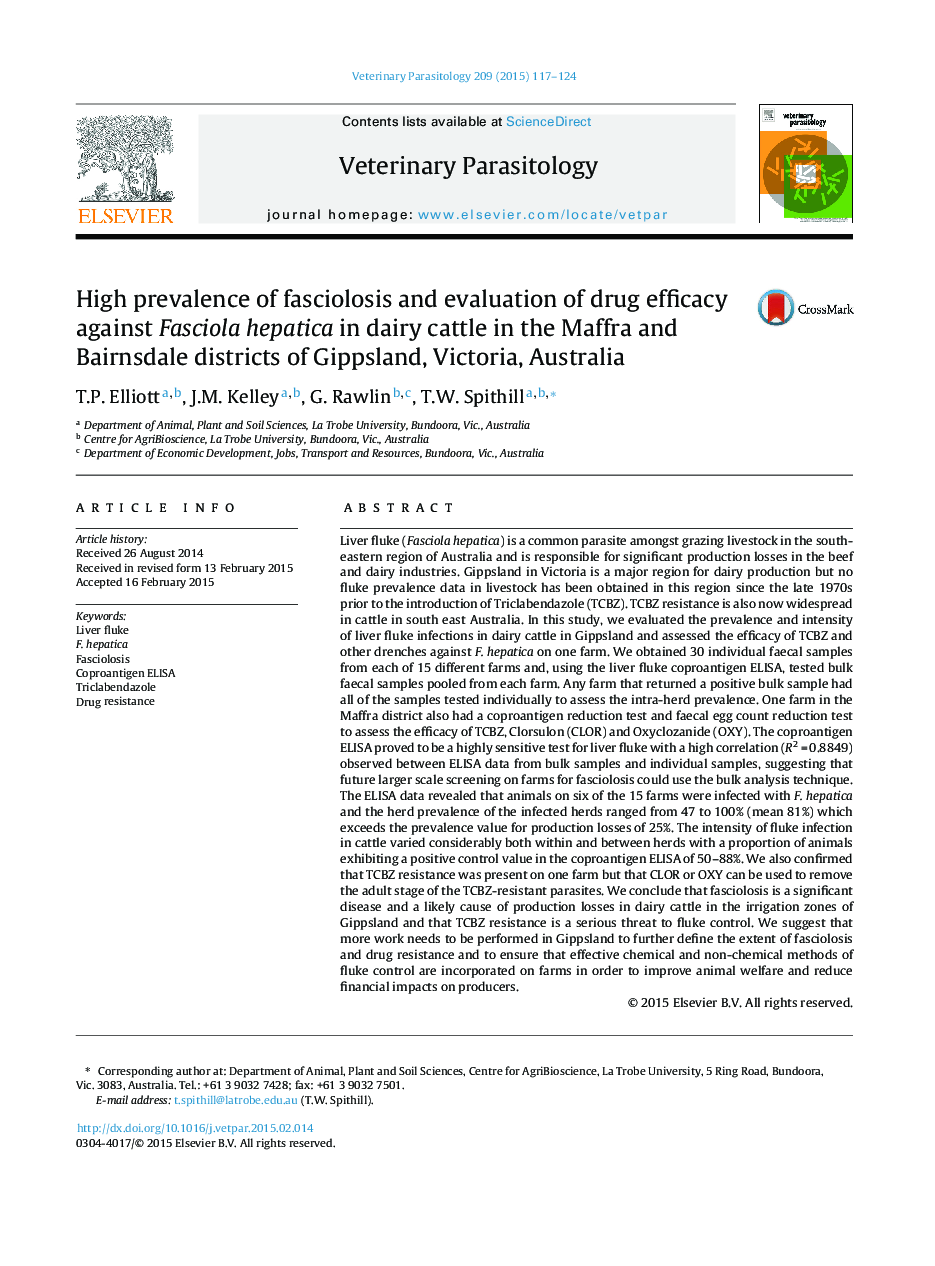| کد مقاله | کد نشریه | سال انتشار | مقاله انگلیسی | نسخه تمام متن |
|---|---|---|---|---|
| 5802566 | 1555673 | 2015 | 8 صفحه PDF | دانلود رایگان |

- 81% mean prevalence of Fasciola in dairy cattle on 6/15 farms tested in Gippsland.
- High correlation (R2Â =Â 0.8849) between bulk and single coproantigen ELISA tests.
- Intensity of fluke infection is high and varies both within and between herds.
- TCBZ-resistant adult liver fluke infections are present on one dairy farm.
- Clorsulon and Oxyclozanide can be used to remove TCBZ-resistant adult flukes.
Liver fluke (Fasciola hepatica) is a common parasite amongst grazing livestock in the south-eastern region of Australia and is responsible for significant production losses in the beef and dairy industries. Gippsland in Victoria is a major region for dairy production but no fluke prevalence data in livestock has been obtained in this region since the late 1970s prior to the introduction of Triclabendazole (TCBZ). TCBZ resistance is also now widespread in cattle in south east Australia. In this study, we evaluated the prevalence and intensity of liver fluke infections in dairy cattle in Gippsland and assessed the efficacy of TCBZ and other drenches against F. hepatica on one farm. We obtained 30 individual faecal samples from each of 15 different farms and, using the liver fluke coproantigen ELISA, tested bulk faecal samples pooled from each farm. Any farm that returned a positive bulk sample had all of the samples tested individually to assess the intra-herd prevalence. One farm in the Maffra district also had a coproantigen reduction test and faecal egg count reduction test to assess the efficacy of TCBZ, Clorsulon (CLOR) and Oxyclozanide (OXY). The coproantigen ELISA proved to be a highly sensitive test for liver fluke with a high correlation (R2Â =Â 0.8849) observed between ELISA data from bulk samples and individual samples, suggesting that future larger scale screening on farms for fasciolosis could use the bulk analysis technique. The ELISA data revealed that animals on six of the 15 farms were infected with F. hepatica and the herd prevalence of the infected herds ranged from 47 to 100% (mean 81%) which exceeds the prevalence value for production losses of 25%. The intensity of fluke infection in cattle varied considerably both within and between herds with a proportion of animals exhibiting a positive control value in the coproantigen ELISA of 50-88%. We also confirmed that TCBZ resistance was present on one farm but that CLOR or OXY can be used to remove the adult stage of the TCBZ-resistant parasites. We conclude that fasciolosis is a significant disease and a likely cause of production losses in dairy cattle in the irrigation zones of Gippsland and that TCBZ resistance is a serious threat to fluke control. We suggest that more work needs to be performed in Gippsland to further define the extent of fasciolosis and drug resistance and to ensure that effective chemical and non-chemical methods of fluke control are incorporated on farms in order to improve animal welfare and reduce financial impacts on producers.
Journal: Veterinary Parasitology - Volume 209, Issues 1â2, 15 April 2015, Pages 117-124